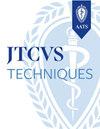Stroke prevention in nonvalvular atrial fibrillation: Thoracoscopic left atrial appendage closure with or without surgical ablation
IF 1.9
Q3 CARDIAC & CARDIOVASCULAR SYSTEMS
引用次数: 0
Abstract
Objectives
Totally thoracoscopic left atrial appendage closure (TT-LAAC) with or without the MAZE procedure is an LAA management technique that prevents cardioembolic events by closing the LAA in patients with atrial fibrillation (AF). Additionally, it facilitates rhythm control with a concurrent a mini-maze procedure. Here we present TT-LAAC outcomes without the MAZE procedure (TT-LAAC) and with the maze procedure (TT-MAZE).
Methods
LAAC and/or bilateral pulmonary vein isolation were performed under complete thoracoscopy, with ablation performed using a radiofrequency device. Patients undergoing both LAAC and ablation were classified as TT-MAZE, whereas those undergoing only closure were classified as TT-LAAC. Successful closure was defined as a stump <10 mm as assessed via intraoperative transesophageal echocardiography.
Results
Between March 2018 and January 2025, 200 patients (155 males, 45 females; mean age, 70.4 ± 9.6 years) underwent TT-MAZE (n = 151) or TT-LAAC (n = 49). AF subtypes included paroxysmal in 62 patients, persistent in 105 patients, and permanent in 33 patients. Closure of the LAA was successful in all patients. No in-hospital mortality was observed. Anticoagulant therapy was discontinued in 96.5% of the patients (n = 193) of patients after 3 months. No postoperative strokes were observed during the mean follow-up of 3 years. In the TT-MAZE group, sinus rhythm was maintained in 72% of patients at 4 years postoperatively.
Conclusions
TT-LAAC procedures effectively prevent cardioembolic stroke even after discontinuation of anticoagulant therapy, regardless of whether sinus rhythm was restored after surgery. These procedures remain a valuable treatment strategy for AF.
非瓣膜性房颤的卒中预防:胸腔镜下左心房附件关闭伴或不伴手术消融
目的胸腔镜左心耳关闭术(TT-LAAC)联合或不联合MAZE手术是一种通过关闭心房颤动(AF)患者的左心耳来预防心脏栓塞事件的LAA管理技术。此外,它便于节奏控制与一个并发的迷你迷宫程序。在这里,我们介绍了没有迷宫手术(TT-LAAC)和迷宫手术(TT-MAZE)的TT-LAAC结果。方法在完全胸腔镜下行slaac和/或双侧肺静脉隔离,射频消融术。同时接受LAAC和消融的患者被分类为TT-MAZE,而仅接受闭合的患者被分类为TT-LAAC。通过术中经食管超声心动图评估,闭合成功定义为残端≥10mm。结果2018年3月至2025年1月,200例患者(男性155例,女性45例,平均年龄70.4±9.6岁)接受了TT-MAZE (n = 151)或TT-LAAC (n = 49)。房颤亚型包括阵发性62例,持续性105例,永久性33例。所有患者均成功关闭LAA。未观察到院内死亡。3个月后,96.5%的患者(n = 193)停止了抗凝治疗。在平均3年的随访期间,未观察到术后卒中。在TT-MAZE组中,72%的患者在术后4年仍保持窦性心律。结论stt - laac手术可有效预防心脏栓塞性卒中,即使在停止抗凝治疗后,无论术后窦性心律是否恢复。这些程序仍然是房颤的一种有价值的治疗策略。
本文章由计算机程序翻译,如有差异,请以英文原文为准。
求助全文
约1分钟内获得全文
求助全文

 求助内容:
求助内容: 应助结果提醒方式:
应助结果提醒方式:


